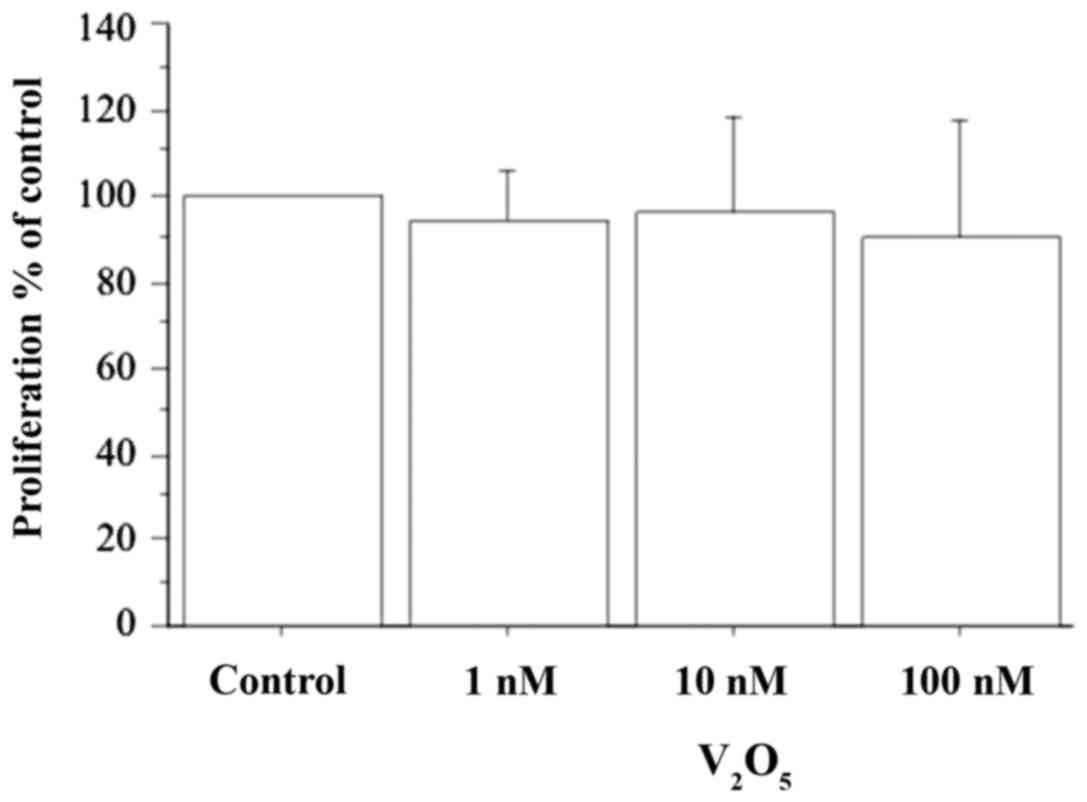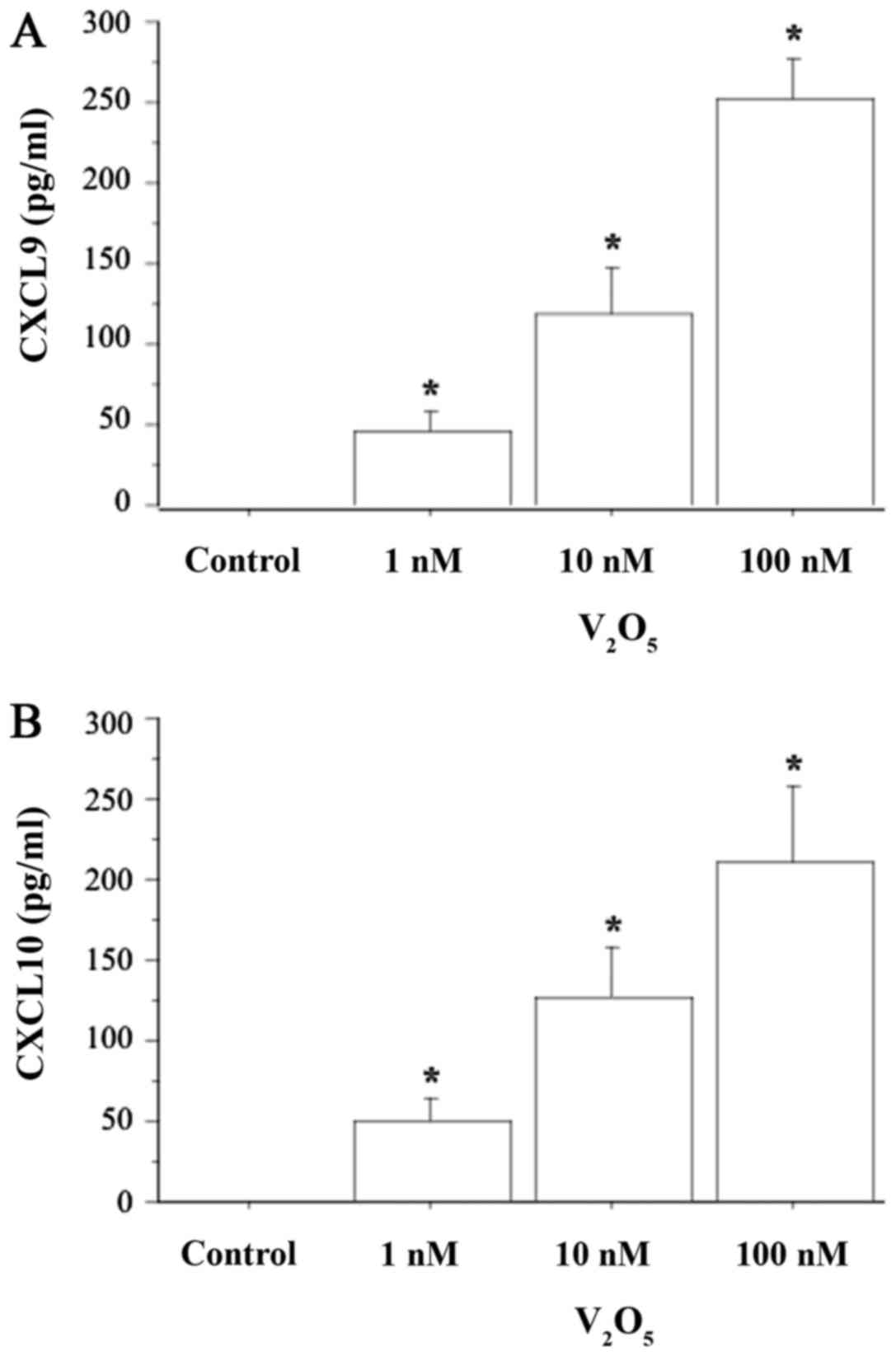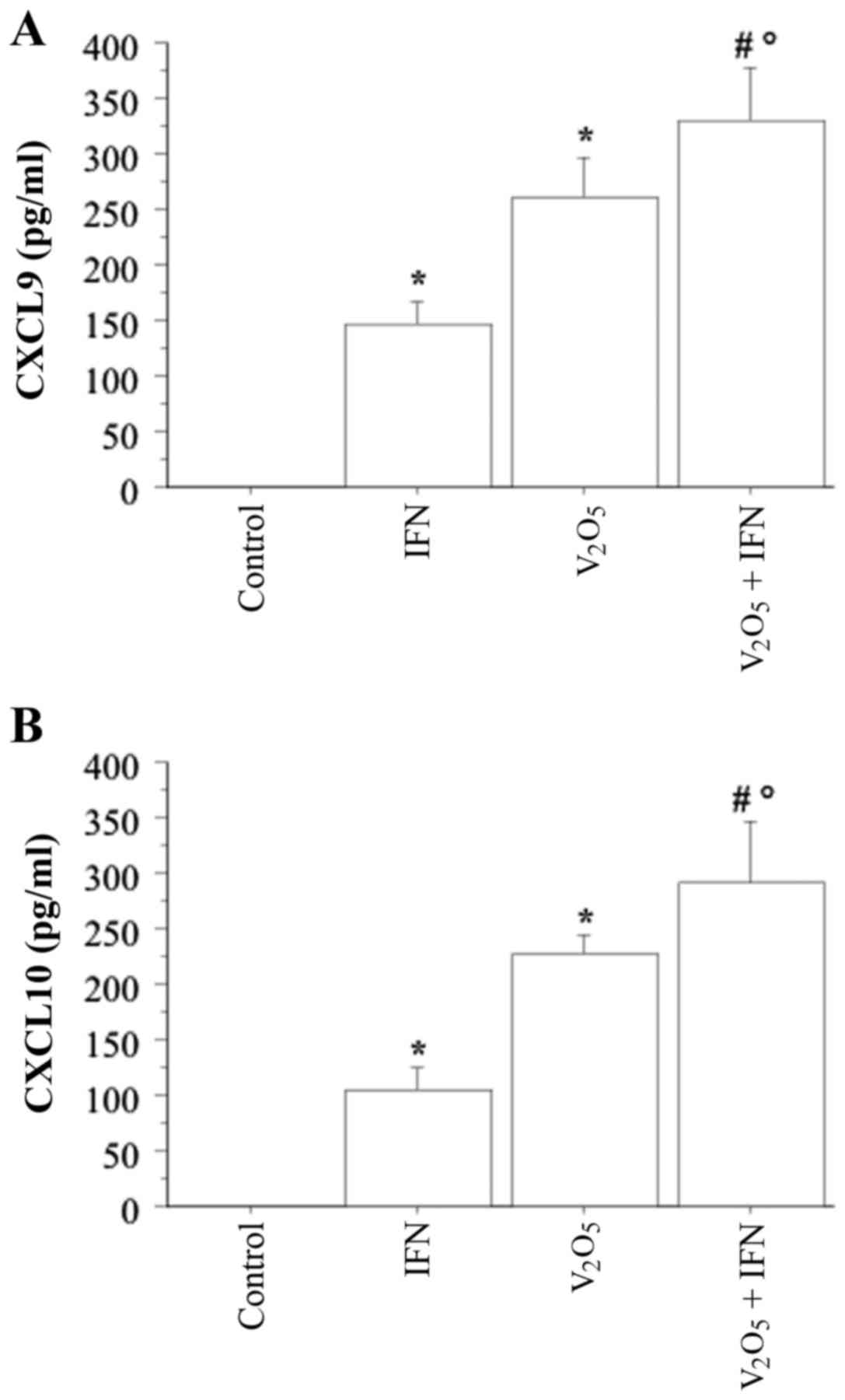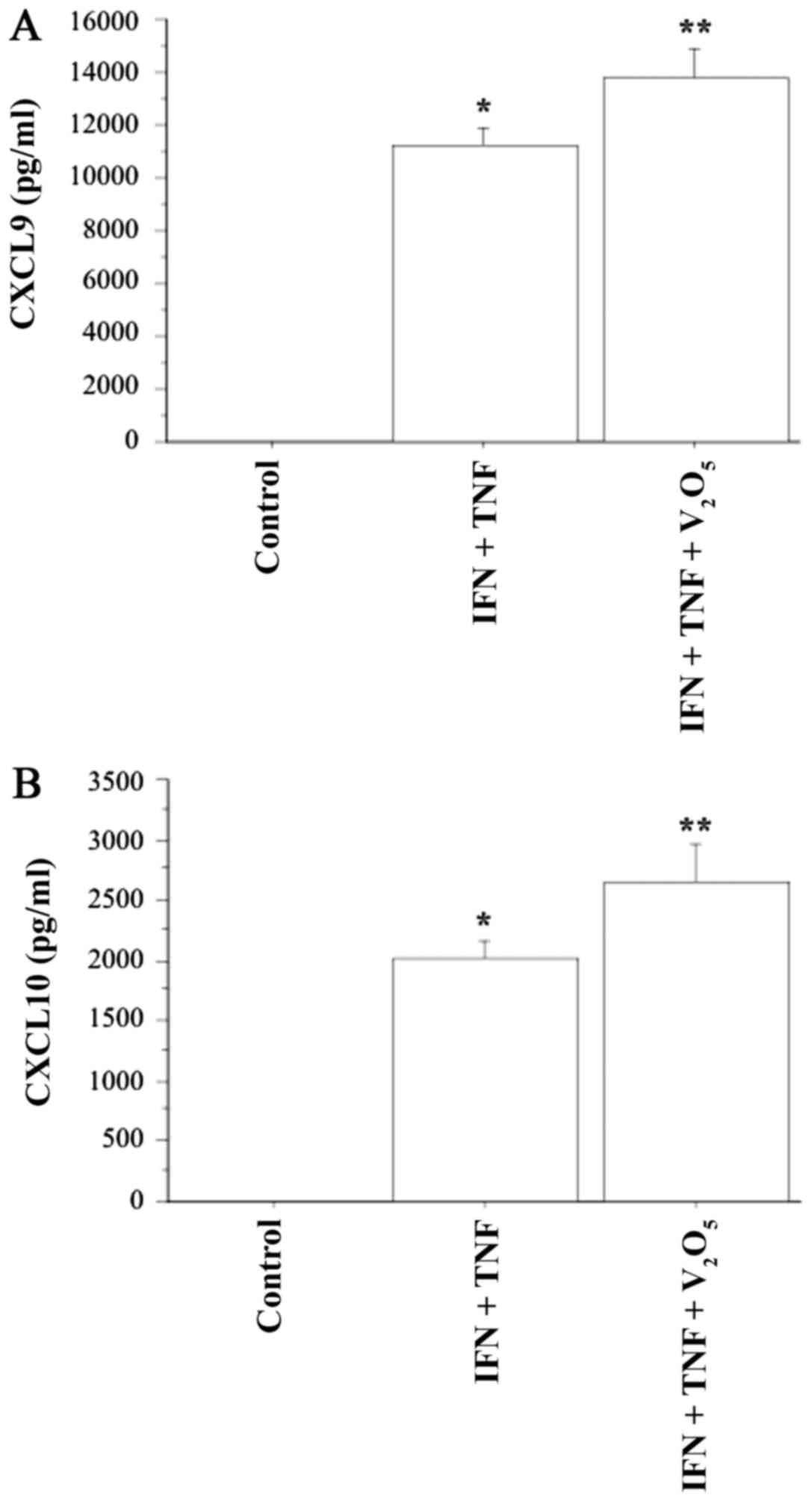Induction of Th1 chemokine secretion in dermal fibroblasts by vanadium pentoxide
- Authors:
- Published online on: March 9, 2018 https://doi.org/10.3892/mmr.2018.8712
- Pages: 6914-6918
Abstract
Introduction
Vanadium is a soft, silvery-grey metal, which exists in a number of different oxidation states (−1, 0, +2, +3, +4 and +5); vanadium pentoxide (V2O5) is the most common commercial form, and most of the studies on toxicity have been conducted on vanadium pentoxide, as it is the primary form found in industrial exposure situations (1). All vanadium compounds are considered toxic. The Occupational Safety and Health Administration (Bellevue, WA, USA) have set an exposure limit for the workplace (considering an 8 h workday, and a 40 h work week), of 0.05 mg/m3 for V2O5 dust and 0.1 mg/m3 for V2O5 fumes (2).
The exposure dose of vanadium that is considered life-threatening is 35 mg/m3 [as determined by the National Institute for Occupational Safety and Health (NIOSH; Washington, DC, USA)], which could cause serious and perpetuating health issues, including death (2). The respiratory system is the most vulnerable to vanadium toxicity, while the effect on the gastrointestinal system is minimal due to the low gut absorption rate (3–5). However, quantitative data are not sufficient to obtain a chronic or subchronic inhalation reference dose.
In rat models, the effects resulting from an inhaled or oral vanadium were evaluated in the sera (6,7), nervous tissue (8), liver (9) and other types of tissue (kidney, gut, lungs) development (10). In vanadium workers (NIOSH 1983) increases in skin rashes and atopic dermatitis have been recorded. To the best of our knowledge, no prior in vivo or in vitro studies have been conducted to evaluate the effect of vanadium exposure on dermal fibroblasts. Here, we evaluated the effect of V2O5 on the proliferation and chemokine secretion profiles of dermal fibroblasts.
Materials and methods
Fibroblast cell cultures
Dermal fibroblasts were obtained from 6 patients who underwent surgery for thyroid nodular goiter (discarded dermal material was used). The local Ethics Committee of the University of Pisa approved the study protocol, and all subjects provided informed consent.
As previously described, tissue explants from the derma were minced and placed in culture dishes, to allow the fibroblasts to proliferate (11). Fibroblasts were propagated in Medium 199 containing 20% FBS (Gibco; Invitrogen, Ltd., Paisley, UK), gentamycin (20 µg/ml) and penicillin (100 U/ml), in a 37°C humidified incubator with 5% of CO2. Cells were subsequently maintained in medium 199 containing 10% FBS (and antibiotics) (12).
Cell viability and proliferation assay
The evaluation of cell proliferation and viability was conducted using a WST-1 assay (Roche Diagnostics, Almere, The Netherlands), which uses MTT (13,14). Fibroblasts were seeded (35,000 cells/ml, in a final volume of 100 µl) into 96-well plates. The effect V2O5 on fibroblast proliferation was determined following exposure of the cells for 24 h to increasing concentrations of V2O5 (1, 10 and 100 nM). Cells were then plated and treated for 24 h with V2O5, or with its vehicle alone; all experiments were performed in triplicate for each cell preparation.
Proliferation assay: cell counting
The cell counting assay was also used to assess fibroblast proliferation (13,14).
Chemokines secretion assays
Chemokine (C-X-C motif) ligand (CXCL)9 and CXCL10 secretion assays were performed by seeding 30,000 cells/ml into 96-well plates, with a final volume of 100 µl/well, in growth medium that was removed after 24 h. Cells were subsequently washed in PBS, then incubated (24 h) in phenol red and serum-free medium with interferon (IFN)-γ (R&D Systems, Minneapolis, MN, USA; 500; 1,000; 5,000; 10,000 IU/ml), and/or 10 ng/ml tumor necrosis factor (TNF)-α (R&D Systems) (11). Preliminary experiments were conducted to select the TNF-α concentration, in order to obtain the highest secretion rate. The supernatants were collected after 24 h, then frozen at −20°C until use in the chemokine assay.
To understand the effect of V2O5 on the chemokine secretion induced by IFN-γ, cells were treated for 24 h with increasing concentrations of V2O5 (1, 10 and 100 nM), in the presence or absence of IFN-γ (1,000 IU/ml), and/or TNF-α (10 ng/ml). An ELISA was used to measure the CXCL9 and CXCL10 levels in the supernatants. The experiments were performed three times for each different cell preparation.
ELISA for CXCL9 and CXCL10
CXCL9 and CXCL10 were assessed in the supernatants obtained from cell cultures, using commercially available kits (R&D Systems). The minimum (mean) detectable doses were 1.5 and 1.2 pg/ml for CXCL9 and CXCL10, respectively. The intra- and inter-assay coefficients of variation were 3.5 and 6.4% respectively, for CXCL9, and 4.5 and 7.3% respectively, for CXCL10. Quality control pools of normal, low and high concentrations were also included in each assay.
Data analysis
For normally distributed variables, values are given as the mean ± SD in text, and in figures, otherwise as the median and interquartile range. Mean group values were compared using one-way analysis of variance (ANOVA) for variables normally distributed variables, or by using the Kruskal-Wallis test or Mann-Whitney U test. Proportions were compared using the Chi-square test. In addition, the Bonferroni-Dunn test was used for the post hoc comparison of normally distributed variables.
Results
Cell proliferation
The WST-1 cell viability and proliferation assay showed that V2O5 (1, 10 and 100 nM) did not alter the viability or proliferation of dermal fibroblasts (Fig. 1). These results were confirmed by a cell counting assay (data not presented).
CXCL9
CXCL9 was not detectable in the supernatants gathered from primary fibroblast samples, whereas its concentration was elevated following IFN-γ dose-dependent induction (0, 75±31, 141±29, 210±35 and 297±74 pg/ml for IFN-γ 0; 500; 1,000; 5,000 and 10,000 IU/ml, respectively; P<0.001, ANOVA). TNF-α alone had no significant impact on CXCL9, which remained undetectable, whereas IFN-γ plus TNF-α exhibited a synergistic effect on the CXCL9 release (CXCL9, 11,154±1,673 vs. 151±42 pg/ml with IFN-γ alone; P<0.0001, ANOVA).
CXCL9 release was dose-dependently stimulated (P<0.0001, ANOVA) when fibroblasts were treated with increasing V2O5 concentrations (1, 10 and 100 nM) (Fig. 2A). Following the treatment of fibroblasts with V2O5 (1, 10 and 100 nM), together with TNF-α, CXCL9 secretion was not significantly changed with respect to V2O5 alone (data not presented). Treating fibroblasts with 100 nM V2O5 plus IFN-γ induced a synergistic increase in CXCL9 release (P<0.0001, ANOVA) (Fig. 3A). When fibroblasts were treated with V2O5 (100 nM), together with IFN-γ and TNF-α stimulation, CXCL9 release was synergistically increased (P<0.0001, ANOVA) (Fig. 4A).
CXCL10
CXCL10 was also not detectable in the supernatants obtained from primary fibroblast cultures under basal conditions. IFN-γ induced CXCL10 secretion dose-dependently (0, 34±18, 107±42, 187±32 and 272±76 pg/ml, respectively, for IFN-γ 0; 500; 1,000; 5,000; 10,000 IU/ml; ANOVA, P<0.001). TNF-α alone did not have a significant impact on CXCL10 secretion, whereas IFN-γ plus TNF-α exhibited a synergistic effect on CXCL10 secretion (3,043±234 vs. 117±27 pg/ml with IFN-γ alone; P<0.0001, ANOVA).
CXCL10 release was dose-dependently stimulated (P<0.0001, ANOVA) when fibroblasts were treated with increasing V2O5 concentrations (1, 10 and 100 nM) (Fig. 2B). Following the treatment of fibroblasts with V2O5 (1, 10 and 100 nM), and together with TNF-α, CXCL10 secretion was not significantly changed with respect to V2O5 alone (data not presented).
Treating fibroblasts with 100 nM V2O5 plus IFN-γ caused a synergistic increase in CXCL10 release (P<0.0001, ANOVA) (Fig. 3B). When fibroblasts were treated with V2O5 (100 nM) together with IFN-γ and TNF-α stimulation, CXCL10 release was also synergistically increased (P<0.0001, ANOVA) (Fig. 4B).
Discussion
The results of the present study demonstrated that V2O5 could promote IFN-γ-dependent chemokine secretion in dermal fibroblasts, without altering their cell proliferation and viability. In addition, our results confirmed that IFN-γ and TNF-α stimulate CXCL9 and CXCL10 secretion, as hypothesized (11,15). It is notable that V2O5 was able to synergize with IFN-γ and TNF-α, further increasing chemokines secretion.
These results are concordant with the hypothesis that V2O5 is able to induce and perpetuate inflammation in the dermal tissues, evolving from a predominant T-helper (Th)1 immune response (13). IFN-γ-inducible C-X-C chemokines are secreted by several types of mammalian cells, including fibroblasts, thyrocytes, islet cells, colon epithelial cells and endothelial cells, among others (11,13–21). These cell types are unable to produce these chemokines under basal conditions; they are induced following stimulation by IFN-γ (alone or in combination with TNF-α), a cytokine that is produced by Th1-activated lymphocytes in several autoimmune diseases, including in the thyroid in Graves' disease, and in autoimmune thyroiditis. It has been hypothesized that this process can be involved in the initiation and/or the perpetuation of various autoimmune disorders (11,13–21), and that it may also be applied to the thyroid.
Our results are concordant with those of other studies in different cell types. V2O5 exposure is a cause of occupational bronchitis; an in vitro study was conducted to evaluate the gene expression profiles of human lung fibroblasts following V2O5 exposure, in order to identify genes that might play a role in the bronchial inflammation, repair and fibrosis during the pathogenesis of bronchitis. A dozen genes are overexpressed by V2O5, including CXCL9 and CXCL10 (1). A further study reported that fibroblasts responded to vanadium oxidative stress by producing IFN-β and activating STAT-1, which lead to increased CXCL10 levels (22), thus serving a role in the innate immune response.
It is notable that vanadium is able to increase chemokine secretion in the dose range of 1–100 nM. Since the normal blood levels of vanadium range from 0.45–18.4 nM, 100 nM could be noted as a dose that might mimic an abnormally high exposure (23). Thus, we could hypothesize that V2O5 in this concentration range is able to induce an inflammatory reaction in dermal tissues, prompting the appearance of skin rashes or atopic dermatitis.
Moreover, it has been shown that exposure of human skin fibroblasts to vanadate causes DNA strand breaks at relevant concentration of 1 µM (24). In the present study we have considered lower concentrations (1, 10 and 100 nM), that did not alter the viability or proliferation of dermal fibroblasts.
In conclusion, the results of our study showed that V2O5 is able to induce Th1 chemokine secretion in dermal tissues, and that it can synergize with important Th1 cytokines (such as IFN-γ and TNF-α), leading to the induction and perpetuation of inflammation in the dermis. Moreover, different genes are overexpressed by V2O5, including CXCL9 and CXCL10, that appear to have important functions in inflammation, fibrosis and repair. To the best of our knowledge, no prior study has evaluated the immune modulatory effects of vanadium in dermal fibroblasts; therefore, our results could be important for evaluating the pathogenesis of clinical dermatological manifestations of vanadium exposure in humans. The induction and perpetuation of inflammation in the dermis and the variety of involved candidate genes could be at the basis of V2O5-induced effects after occupational and environmental exposures. Additional studies are required to assess dermal integrity, as well as the manifestations of toxicity in subjects who are occupationally exposed, or are living in polluted areas.
Acknowledgements
Not applicable.
Funding
No funding was received.
Availability of data and materials
All data generated or analyzed during this study are included in this published article.
Authors' contributions
PF, RF, AC, AA and SMF made substantial contributions to the conception and design of the study and to the acquisition of the data. GE, FR, AP, GG, GF and SB analysed the data. PF, AA and SMF. have been involved in drafting the manuscript. AA critically revised the manuscript for important intellectual content.
Ethics approval and consent to participate
Not applicable.
Consent for publication
Not applicable.
Competing interests
The authors confirm that they have no competing interests.
References
|
Ingram JL, Antao-Menezes A, Turpin EA, Wallace DG, Mangum JB, Pluta LJ, Thomas RS and Bonner JC: Genomic analysis of human lung fibroblasts exposed to vanadium pentoxide to identify candidate genes for occupational bronchitis. Respir Res. 8:342007. View Article : Google Scholar : PubMed/NCBI | |
|
Occupational Safety and Health Administration (OSHA): Occupational safety and health guideline for vanadium pentoxide dust. OSHA; Washington, DC: 2007 | |
|
Sax NI: Dangerous Properties of Industrial Materials. 6th. Van Nostrand Reinhold Company; New York, NY: pp. 2717–2720. 1984 | |
|
Ress NB, Chou BJ, Renne RA, Dill JA, Miller RA, Roycroft JH, Hailey JR, Haseman JK and Bucher JR: Carcinogenicity of inhaled vanadium pentoxide in F344/N rats and B6C3F1 mice. Toxicol Sci. 74:287–296. 2003. View Article : Google Scholar : PubMed/NCBI | |
|
Wörle-Knirsch JM, Kern K, Schleh C, Adelhelm C, Feldmann C and Krug HF: Nanoparticulate vanadium oxide potentiated vanadium toxicity in human lung cells. Environ Sci Technol. 41:331–336. 2007. View Article : Google Scholar : PubMed/NCBI | |
|
Scibior A, Zaporowska H and Ostrowski J: Selected haematological and biochemical parameters of blood in rats after subchronic administration of vanadium and/or magnesium in drinking water. Arch Environ Contam Toxicol. 51:287–295. 2006. View Article : Google Scholar : PubMed/NCBI | |
|
González-Villalva A, Fortoul T, Avila-Costa MR, Piñón-Zarate G, Rodriguez-Laraa V, Martínez-Levy G, Rojas-Lemus M, Bizarro-Nevarez P, Díaz-Bech P, Mussali-Galante P and Colin-Barenque L: Thrombocytosis induced in mice after subacute and subchronic V2O5 inhalation. Toxicol Ind Health. 22:113–116. 2006. View Article : Google Scholar : PubMed/NCBI | |
|
Soazo M and Garcia GB: Vanadium exposure through lactation produces behavioral alterations and CNS myelin deficit in neonatal rats. Neurotoxicol Teratol. 29:503–510. 2007. View Article : Google Scholar : PubMed/NCBI | |
|
Kobayashi K, Himeno S, Satoh M, Kuroda J, Shibata N, Seko Y and Hasegawa T: Pentavalent vanadium induces hepatic metallothionein through interleukin-6-dependent and -independent mechanisms. Toxicology. 228:162–170. 2006. View Article : Google Scholar : PubMed/NCBI | |
|
Barceloux DG: Vanadium. J Toxicol Clin Toxicol. 37:265–278. 1999. View Article : Google Scholar : PubMed/NCBI | |
|
Antonelli A, Ferri C, Fallahi P, Ferrari SM, Frascerra S, Sebastiani M, Franzoni F, Galetta F and Ferrannini E: High values of CXCL10 serum levels in patients with hepatitis C associated mixed cryoglobulinemia in presence or absence of autoimmune thyroiditis. Cytokine. 42:137–143. 2008. View Article : Google Scholar : PubMed/NCBI | |
|
Valyasevi RW, Harteneck DA, Dutton CM and Bahn RS: Stimulation of adipogenesis, peroxisome proliferator-activated receptor-gamma (PPARgamma), and thyrotropin receptor by PPARgamma agonist in human orbital preadipocyte fibroblasts. J Clin Endocrinol Metab. 87:2352–2358. 2002. View Article : Google Scholar : PubMed/NCBI | |
|
Antonelli A, Rotondi M, Fallahi P, Romagnani P, Ferrari SM, Buonamano A, Ferrannini E and Serio M: High levels of circulating CXC chemokine ligand 10 are associated with chronic autoimmune thyroiditis and hypothyroidism. J Clin Endocrinol Metab. 89:5496–5499. 2004. View Article : Google Scholar : PubMed/NCBI | |
|
Kemp EH, Metcalfe RA, Smith KA, Woodroofe MN, Watson PF and Weetman AP: Detection and localization of chemokine gene expression in autoimmune thyroid disease. Clin Endocrinol (Oxf). 59:207–213. 2003. View Article : Google Scholar : PubMed/NCBI | |
|
Antonelli A, Ferrari SM, Fallahi P, Frascerra S, Santini E, Franceschini SS and Ferrannini E: Monokine induced by interferon gamma (IFNgamma) (CXCL9) and IFNgamma inducible T-cell alpha-chemoattractant (CXCL11) involvement in Graves' disease and ophthalmopathy: Modulation by peroxisome proliferator-activated receptor-gamma agonists. J Clin Endocrinol Metab. 94:1803–1809. 2009. View Article : Google Scholar : PubMed/NCBI | |
|
Antonelli A, Ferrari SM, Frascerra S, Pupilli C, Mancusi C, Metelli MR, Orlando C, Ferrannini E and Fallahi P: CXCL9 and CXCL11 chemokines modulation by peroxisome proliferator-activated receptor-alpha agonists secretion in Graves' and normal thyrocytes. J Clin Endocrinol Metab. 95:E413–E420. 2010. View Article : Google Scholar : PubMed/NCBI | |
|
Garcià-Lòpez MA, Sancho D, Sànchez-Madrid F and Marazuela M: Thyrocytes from autoimmune thyroid disorders produce the chemokines IP-10 and Mig and attract CXCR3v lymphocytes. J Clin Endocrinol Metab. 86:5008–5016. 2001. View Article : Google Scholar : PubMed/NCBI | |
|
Antonelli A, Ferrari SM, Corrado A, Ferrannini E and Fallahi P: CXCR3, CXCL10 and type 1 diabetes. Cytokine Growth Factor Rev. 25:57–65. 2014. View Article : Google Scholar : PubMed/NCBI | |
|
Antonelli A, Ferrari SM, Giuggioli D, Ferrannini E, Ferri C and Fallahi P: Chemokine (C-X-C motif) ligand (CXCL)10 in autoimmune diseases. Autoimmun Rev. 13:272–280. 2014. View Article : Google Scholar : PubMed/NCBI | |
|
Antonelli A, Fallahi P, Delle Sedie A, Ferrari SM, Maccheroni M, Bombardieri S, Riente L and Ferrannini E: High values of Th1 (CXCL10) and Th2 (CCL2) chemokines in patients with psoriatic arthtritis. Clin Exp Rheumatol. 27:22–27. 2009.PubMed/NCBI | |
|
Fallahi P, Ferrari SM, Ruffilli I, Elia G, Biricotti M, Vita R, Benvenga S and Antonelli A: The association of other autoimmune diseases in patients with autoimmune thyroiditis: Review of the literature and report of a large series of patients. Autoimmun Rev. 15:1125–1128. 2016. View Article : Google Scholar : PubMed/NCBI | |
|
Antao-Menezes A, Turpin EA, Bost PC, Ryman-Rasmussen JP and Bonner JC: STAT-1 signaling in human lung fibroblasts is induced by vanadium pentoxide through an IFN-beta autocrine loop. J Immunol. 180:4200–4207. 2008. View Article : Google Scholar : PubMed/NCBI | |
|
Sabbioni E, Kuèera J, Pietra R and Vesterberg O: A critical review on normal concentrations of vanadium in human blood, serum, and urine. Sci Total Environ. 188:49–58. 1996. View Article : Google Scholar : PubMed/NCBI | |
|
Ivancsits S, Pilger A, Diem E, Schaffer A and Rüdiger HW: Vanadate induces DNA strand breaks in cultured human fibroblasts at doses relevant to occupational exposure. Mutat Res. 519:25–35. 2002. View Article : Google Scholar : PubMed/NCBI |













